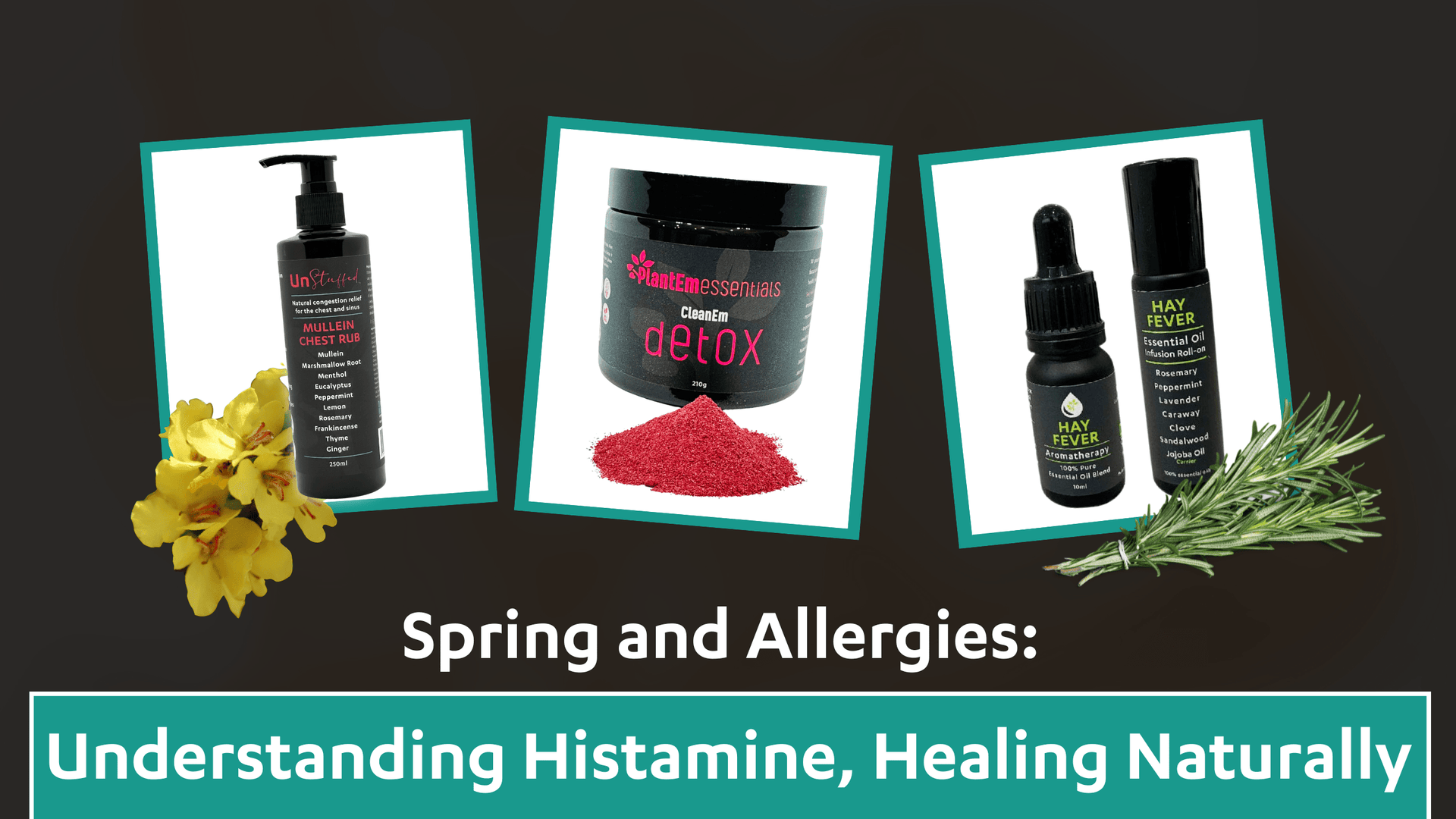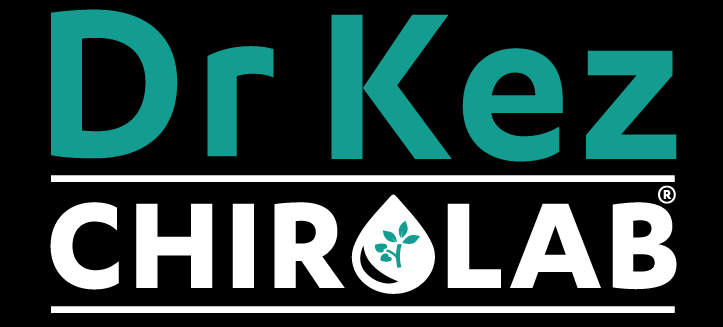
Spring and Allergies: Understanding Histamine, Healing Naturally
As winter thaws and the blossoms return, spring can feel like a breath of fresh air, unless you're one of the millions who dread it due to hay fever, sinus congestion and relentless sneezing. While flowers bloom and trees bud, the airborne allergens they release can trigger a cascade of responses in the body.
But why does this happen? And is the conventional approach of popping antihistamines the only, or best option?
Let’s dive into what’s actually happening inside your body during an allergic reaction, what histamine is really doing, and explore natural ways to support your system without suppressing its essential functions.

Histamine is often framed as the enemy during allergy season, but in reality, it’s a vital part of your immune and nervous systems. Produced by immune cells called mast cells and basophils, histamine plays a key role in defending the body.
Essential Functions of Histamine:

Immune Response: Histamine is released as a signal when your body identifies a potential threat (like pollen or dust). It increases blood flow to affected areas, helping immune cells respond more quickly.
Stomach Acid Production: Histamine triggers the production of hydrochloric acid in the stomach, aiding digestion and nutrient absorption.
Brain Function: Histamine acts as a neurotransmitter, supporting alertness, attention, learning and memory.
Wound Healing & Inflammation Regulation: It helps draw immune cells to sites of tissue damage, assisting in the healing process.
So while it’s true that histamine causes symptoms like sneezing, itching and watery eyes, these are side effects of your body doing its job, alerting and protecting itself. The trouble arises when this response becomes exaggerated or misdirected, as in allergies or histamine intolerance.

Many people confuse allergies and histamine intolerance, but they’re two very different mechanisms.

Allergic Reaction:
- Triggered by allergens (pollen, dust, pet dander)
- Involves IgE antibodies and immune memory
- Causes histamine release from mast cells
- Symptoms: sneezing, runny nose, itchy eyes, hives, coughing

Histamine Intolerance:
- Caused by too much histamine in the body, or reduced ability to break it down
- Often due to enzyme deficiencies (especially DAO - diamine oxidase)
- Triggered by histamine-rich foods (aged cheese, red wine, fermented foods)
- Symptoms: flushing, headaches, nasal congestion, fatigue, anxiety, gut upset
Understanding the difference can help you better navigate your symptoms and choose appropriate support strategies.

When you inhale pollen, your immune system may wrongly identify it as a dangerous invader. It responds by releasing histamine to protect the sensitive epithelial linings of the nose, sinuses, eyes and throat.

Histamine causes:
- Dilation of blood vessels (resulting in redness and swelling)
- Increased permeability (leading to runny noses and watery eyes)
- Stimulation of nerve endings (causing itching and sneezing)
- Contraction of smooth muscles (triggering coughing or wheezing)
While these actions are designed to flush out the irritant, repeated and prolonged exposure leads to inflammation and damage of the epithelial tissues. That’s when symptoms start to feel chronic, not just seasonal.

Synthetic antihistamines block histamine receptors in the body, preventing histamine from binding and triggering symptoms. While this might bring short-term relief, it can come at a cost.

Side Effects of Synthetic Antihistamines:
- Drowsiness or brain fog
- Dry mouth, nose and eyes
- Constipation or urinary retention
- Altered gut function (due to histamine’s role in digestion)
- Suppression of immune response
And importantly, these medications suppress histamine systemically, not just where the issue is occurring (e.g. in the nose or sinuses). That means they may interfere with your stomach acid, brain function and other crucial systems, not ideal for long-term health.

Instead of blocking histamine everywhere in the body, what if we supported the local area of irritation and gave the body what it needs to heal the epithelial damage, reduce inflammation and restore balance?
That’s the philosophy behind some of our most loved natural solutions for hay fever and springtime congestion.


Our UnStuffed™ Chest Rub contains soothing mullein leaf, eucalyptus, marshmallow root, peppermint and other natural botanicals designed to help:
- Soothe irritated nasal and sinus passages
- Support healthy mucus drainage
- Calm inflammation
- Promote healing of damaged epithelial linings
Applied topically to the chest, neck or even under the nose, UnStuffed™ allows these powerful herbs to be absorbed through the skin, delivering local, plant-based support, without systemic interference.
This gentle yet effective remedy doesn’t suppress the body’s natural responses but supports the repair and regulation of inflamed tissues, helping you breathe easier the natural way.

Our Hay Fever Aromatherapy Range is a targeted blend of therapeutic essential oils designed to ease sinus congestion, reduce irritation and support calm breathing, without suppressing your body’s natural defence mechanisms.
This carefully formulated blend includes:

Rosemary – A powerful decongestant and anti-inflammatory and anti-histamine that helps open airways and clear the head

Peppermint – Cools and soothes inflamed sinus tissues, eases nasal blockage, promotes clear breathing and helps to reduce irritation that triggers histamine release

Lavender – Calms the nervous system, reduces allergic irritation, promotes relaxation and helps to stabilise mast cells (reducing histamine release)

Caraway – Traditionally used to relieve respiratory discomfort, calm mucous membrane inflammation and has anti-microbial properties

Clove – Offers antimicrobial properties and reduces swelling in sensitive nasal tissues, helping with sinus congestion and infections

Sandalwood – Soothes dry, irritated airways and supports respiratory ease with its calming aroma
Use it as a roll-on, steam inhalation, bath addition or diffuser oil to naturally ease symptoms and support your respiratory system during allergy season. Gentle yet effective, this blend works with your body to calm the chaos of spring.
This natural approach helps the body recalibrate rather than override its messaging system.

For those looking for gentle internal support, our Hay Fever Homeopathic Oral Spray may help desensitise the body to common allergens, especially when used consistently.
This remedy works with the body’s own regulatory mechanisms, not against them, helping to reduce sensitivity over time without the side effects often associated with pharmaceuticals.

When it comes to managing allergies and histamine responses, most people focus on the immune system or sinuses, but there's another key player working quietly in the background: your liver.
Your liver is responsible for breaking down and removing excess histamine and inflammatory compounds from your system. If liver function is sluggish or overburdened, whether from diet, medications, environmental toxins or stress, your ability to clear histamine efficiently is compromised. This can result in an exaggerated or prolonged histamine response, making your symptoms worse and more persistent.

How the Liver Helps:
- Metabolises histamine via specific enzymes
- Clears toxins and inflammatory byproducts from the bloodstream
- Supports immune regulation and inflammatory balance
That’s why supporting detox pathways is an essential part of allergy management, especially during spring, when histamine load is at its highest.


Our CleanEm Detox powder is a whole food-based formula designed to support liver function, lymphatic drainage and cellular detoxification. It’s loaded with nutrient-rich whole food ingredients and phytonutrients that help:
- Stimulate liver enzymes
- Promote bile flow (which carries toxins out of the body)
- Reduce the overall toxic load on the system
- Clear excess histamine more efficiently
By reducing the burden on your liver, you’re giving your body the best chance to respond calmly and recover quickly, rather than react with alarm bells every time spring rolls around.

Allergies are a sign of your body trying to protect you, but sometimes that protection goes into overdrive. Instead of shutting it down with broad-spectrum antihistamines, consider a more targeted, supportive approach.
Try These Steps:
-
Minimise exposure to pollen (keep windows closed during high pollen times, use air purifiers, shower after being outdoors)

- Eat an anti-inflammatory diet (high in greens, low in histamine-rich foods)
- Support your gut (histamine degradation happens in the gut, our FeedEm Prebiotics can help restore balance)
- Use natural topical and aromatic supports like UnStuffed™, the Aromatherapy Hay Fever Roll-On and Pure 100% oil blend and our Homeopathic Spray
- Support your liver daily with gentle detoxification from CleanEm Detox
- Rest, hydrate and allow your body to heal from the inside out

This spring, instead of simply muting your symptoms with systemic medications, consider working with your body.
By understanding the true role of histamine, and how to support the organs responsible for breaking it down, you can ease your allergy symptoms more gently and sustainably. Whether it’s healing your epithelial lining with the help of UnStuffed™ Chest Rub, calming irritation with the Hay Fever Aromatherapy Range, or aiding detoxification with CleanEm Detox, there’s a natural path forward.
Allergies may be common, but suffering through them doesn’t have to be.









